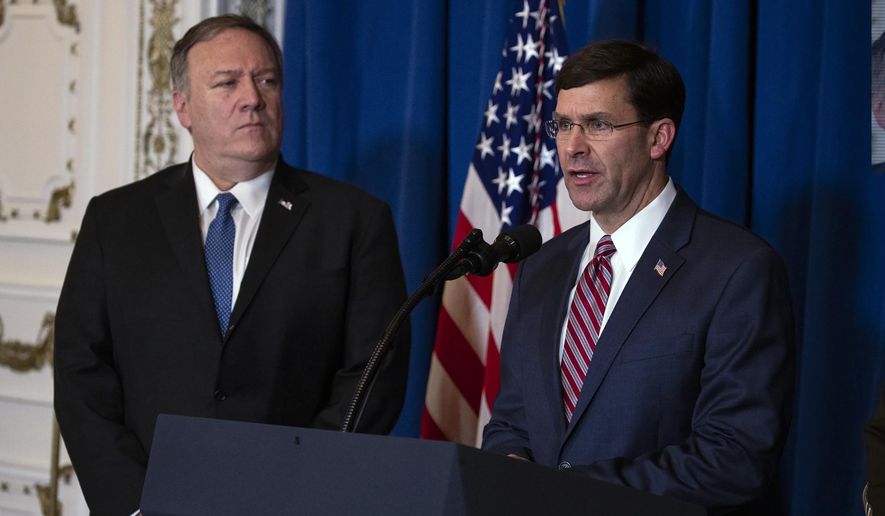Secretary of State Mike Pompeo was assured by Iraqi leaders in a phone call Tuesday that they would “guarantee the safety” of American personnel in Iraq after Iraqi Shiite militiamen broke into the U.S. Embassy compound in Baghdad, U.S. officials said.
Mr. Pompeo’s call with Iraqi Prime Minister Adil Abdul-Mahdi and President Barham Salih came as President Trump blamed Iran for attacking the embassy compound in retaliation for U.S. airstrikes on Sunday targeting an Iran-backed militia in Iraq that had killed an American contractor there.
“Iran killed an American contractor, wounding many,” Mr. Trump tweeted Tuesday morning. “We strongly responded, and always will. Now Iran is orchestrating an attack on the U.S. Embassy in Iraq. They will be held fully responsible. In addition, we expect Iraq to use its forces to protect the Embassy, and so notified!”
The warning added a fresh layer to the escalation occurring between the U.S. and Iran inside Iraq. The Associated Press reported Tuesday that flames were rising from inside the American Embassy compound while at least three U.S. soldiers could be seen on the roof of the main embassy building in the Iraqi capital.
The news agency reported that dozens of Iraqi Shiite militiamen and their supporters had broken into the compound, smashing a main door and setting fire to a reception area, prompting tear gas and the sounds of gunfire.
Reuters reported that the protesters threw stones at the compound’s main gate while others chanted, “No, no, America! No, no, Trump!”
SEE ALSO: Militiamen breach U.S. Embassy in Baghdad; Trump blames Iran
Some in Washington quickly asserted that the chanting and overall attack on the embassy was part of a contrived, Iranian-backed plot.
Former National Security Adviser John R. Bolton tweeted that the attack was “straight from Iran’s playbook in 1979.”
“It’s a sign of Iranian control over Shia militia groups, not a sign of Iraqi anti-Americanism,” Mr. Bolton said. “We must protect our citizens from Iranian belligerence.”
A Reuters report also said Iraqi special forces had been deployed around the main gate to prevent the hostile crowd from entering the embassy — and that U.S.-trained and -equipped Iraqi Counter-Terrorism forces later reinforced the Iraqi special forces.
There was a fire at the reception area near the parking lot of the embassy compound, but it was unclear what had caused it. A man on a loudspeaker urged the mob not to enter the compound, saying: “The message was delivered.”
There were no reports of casualties, but the unprecedented breach was one of the worst attacks on the embassy in recent memory.
Various reports said U.S. Ambassador Douglas Sillman was evacuated from the embassy, although some claimed he was outside the country on a previously scheduled trip when the protests erupted.
The AP reported that the embassy’s security team had evacuated some local staff from a rear gate while others left by helicopters as the rest remained inside “safe” areas within the embassy.
Tuesday’s developments followed deadly U.S. airstrikes on Sunday that killed 25 fighters of the Iranian-backed militia in Iraq, the Kataeb Hezbollah.
Prior to Mr. Trump’s tweet on Tuesday morning, U.S. military officials had said Sunday’s airstrikes were taken in retaliation for last week’s killing of an American contractor in a rocket attack on an Iraqi military base that it had blamed on the militia.
State Department spokesperson Morgan Ortagus said in a statement Tuesday that Mr. Pompeo had “made clear” in his call with Iraq’s president and prime minister that “the United States will protect and defend its people, who are there to support a sovereign and independent Iraq.”
“Both Abdul-Mahdi and Salih assured the Secretary that they took seriously their responsibility for and would guarantee the safety and security of U.S. personnel and property,” Ms. Ortagus said.
• This article is based in part on wire service reports.
• Guy Taylor can be reached at gtaylor@washingtontimes.com.




Please read our comment policy before commenting.